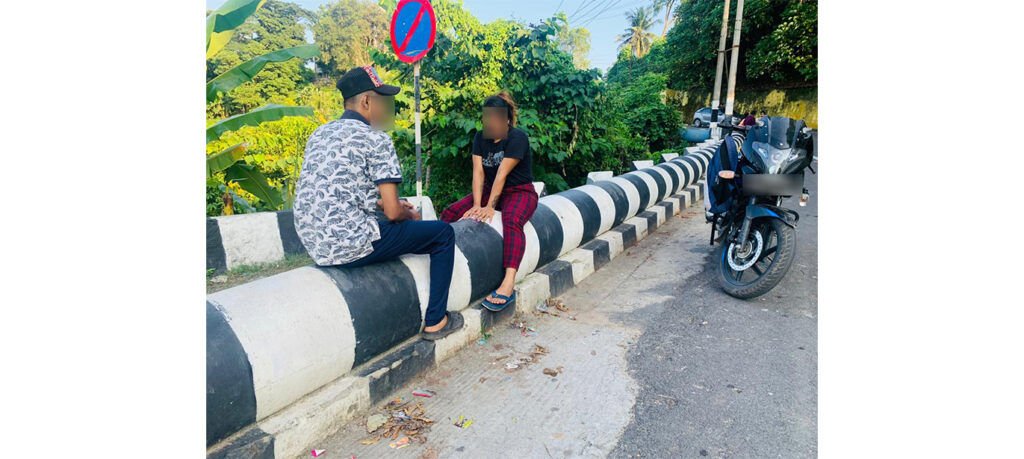Smita provided us with feedback on the addiction to recovery model by testing if she could use it to trace her pathway. Like many women in Assam, Smita did not have access to a residential rehabilitation programme. However, she was helped indirectly through the rehab facility run by her older brother and illustrates, what may be a rare pathway to recovery directly from abstinence into recovery without receiving, extended professional support. Here is Smita’s journey to recovery.
For a description of our Pathways to Recovery Model click here

Phase 1. Recreational Use≫
Smita thought she might have always been prone to addiction and viewed herself as demanding, stubborn, and given to fits of rage when she did not get what she wanted. On the other hand, she saw her older brother being pampered by their parents. It seemed he was given everything he wanted while he just indulged himself in drugs. Her brother had 23 rounds of treatment and finally got clean. However, during this time Smita felt her parents “forgot that they had a daughter too”. She felt it was unfair that, while she had stayed clean, it was she who suffered the consequences of her brother’s addiction. At the same time, she was trying to manage a long-term relationship with her boyfriend who was also deep in addiction.
The first time Smita tried alcohol it was out of anger, curiosity, and spite as she grew tired of seeing the men around her using substances while she missed out. She said: “You like alcohol so much? One day I will try too. What is this thing? My brother also likes drinking it a lot. You also like it a lot. Dad too likes it. What is this thing? I will try this time.’”

Phase 2a. Relaxed Addiction≫
At first Smita’s drinking was just casual but her relationship problems started affecting her education and she changed her school. She said: “I met friends who were older than me. Then there was no stop to drinking alcohol.” This continued when she went to college where she started using more substances and was a very difficult time for Smita: “It is such a page in my story. That page I do not let anyone read. I always skip that. So with them I got into using. I used upper drugs. To drink you need a gathering. Drugs doesn’t require a gathering.”
Smita did not inject drugs fearing she would be caught like her brother because of the marks. She was terrified of rehab because of what her brother had told her and wanted to avoid it at all cost. However, later she learned that her brother made rehab sound dreadful because he wanted the family to let him come home so he could start using again.
As time passed Smita looked for more and more intoxication. She explained: “Suppose when you make a vegetable dish the spice isn’t coming up to taste. If you give more spice maybe the vegetable dish will be more tasty. It was that type. That, this in present day, this much quantity isn’t giving me a trip. Let me add another two or three substances then I will get more trip.” However, Smita realised she was going deeper into addiction and reached out: “Then slowly, slowly what happened is so I told mom. I thought then that no it’s a lot now and at that point you can relate this too. I was very stuck at a point in life.”

Phase 2b. Chaotic Addiction≫
Smita tried quitting on her own. assuming she would be able to stop without help. However, she could not stay abstinent for long and soon found herself having cravings and she started using again.
“I went to abstinent recovery once, thought I’ll be able to stay there. But I couldn’t. Again I returned, after returning again I entered addiction”
Interestingly, Smita remembered this while tracing her pathway on the map and did not mention it in her original interview. This suggests the value of the map as a catalyst for reviewing and integrating the difficult and complex experiences of addiction.

Stage 3b. ‘Abstinence’ into Stage 5. ‘In Recovery’ (Bypassing Phase 3. Supported Recovery)≫
It was not through professional help, but through motivation from her friend that led her to ultimately quit. She met a man in her brother’s rehab who helped her get to a turning point. Their conversations supported her to stop using, change her lifestyle, and develop a strong motivation to stay clean. She experienced a revelation about her drug taking: “That day I broke. No I am not powerless. I won’t be powerless with you. I go and buy you. Do you come to buy me? I go to the shop to buy you.” They developed a close relationship and just being listened to helped Smita immensely: “He only listened. He didn’t make me listen. You understand the difference?”
At the time of interview, Smita supports her brother’s rehab centre and assists others in their recovery journey.

Smita’s poster – This is Smita’s message







